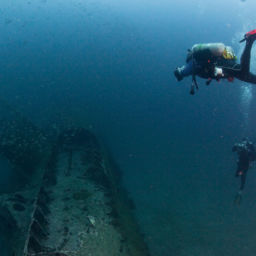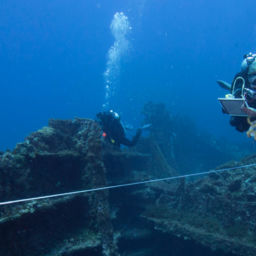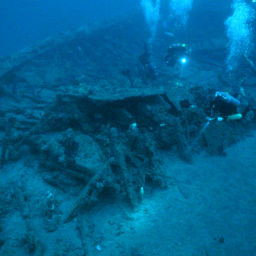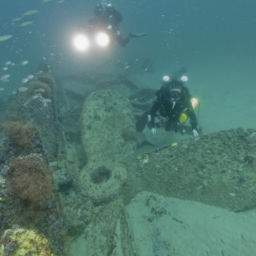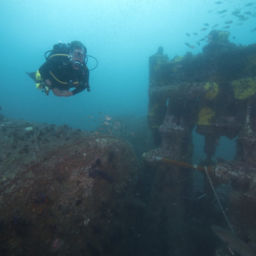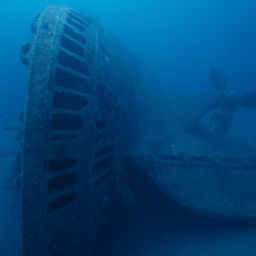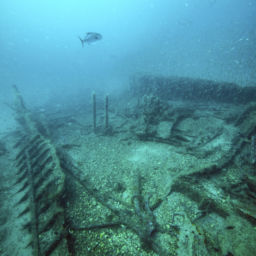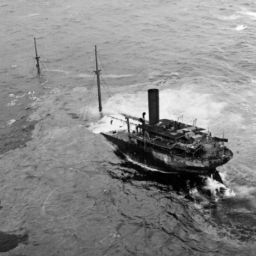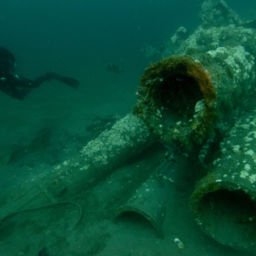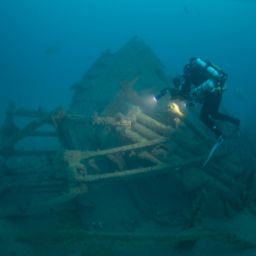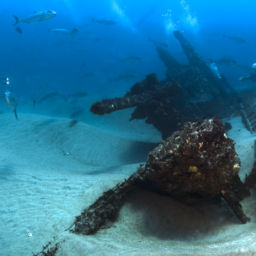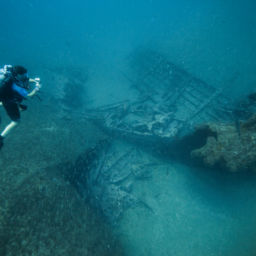From January to the end of August 1942, German U-boats attacked more than 285 vessels in North American waters. Just off coastal North Carolina, the remnants of many of these ships are scattered on the ocean floor. The remains of this little-known battlefield serve as the final resting place for 90 ships and nearly 1,700 men lost during the Battle of the Atlantic. Over the course of the battle, eight Allied convoy vessels, 78 merchant freighters and tankers and four German U-boats sank off North Carolina’s coast. Each shipwreck tells a unique story; today we visit the U-352.
U-352 sinks
On April 7, 1942, the German submarine U-352 headed for the U.S. East Coast to begin patrolling the coastline for merchant and Allied vessels. As U-352 reached the U.S. on May 5, it was far out to sea off Cape Hatteras, North Carolina. Here it began to play a game of cat-and-mouse with a Swedish merchant ship, SS Freden. After several attempts over a two-day period of firing torpedoes and missing, U-352 went to find other targets.
Just a few days later, on May 9, U-352 began the engagement that would end in its demise. U-352’s captain spotted Icarus, a 165-foot (50 m) U.S. Coast Guard cutter, on antisubmarine patrol off Cape Lookout, North Carolina. U-352 closed in for attack, but shortly before the captain fired his torpedoes, Icarus got a sonar contact. U-352 fired at Icarus, but the torpedo either malfunctioned or hit the sea bottom.
In response to the sonar contact, Icarus sent out five depth charges, damaging U-352 so badly that the captain decided to play dead on the ocean floor, hoping to go unnoticed. Icarus continued to drop depth charges systematically and eventually forced U-352 to surface. As the U-352 crew prepared to scuttle the ship before it could be captured, several crewmen emerged from the conning tower. Fearing that they might attempt to man the deck guns, Icarus began delivering heavy machine-gun fire, which resulted in the deaths of several crew members aboard the U-boat.
U-352 sank, making it the first U-boat that the U.S Coast Guard sank off the American East Coast during World War II. Although most of the crew escaped, Icarus did not rescue them immediately. It left the area for approximately an hour to await instructions on how to proceed. When Icarus returned to the site, it collected 33 survivors although one of them died aboard Icarus shortly thereafter. The Icarus took the remaining survivors to Charleston, South Carolina for interrogation. They remained in various POW camps for the duration of the war, often intermingling with survivors from U-701.
Diving U-352
Of the four U-boats off North Carolina’s coast, U-352 was the least successful in its operational career. It sank no ships during the month it patrolled the U.S. coast. However, divers frequent this wreck more often than any other U-boat off North Carolina’s coast. Unlike U-85 and U-701, U-352 rests south of Cape Hatteras off Cape Lookout. Sitting in calmer conditions and in more inviting, warm and clear Gulf Stream water, the site is one of the country’s most popular wreck dives.
Sea life at the wreck site is prolific and typical of a sub-tropical marine ecosystem. Coralline algae heavily encrusts the site, which supports an array of sea anemones and corals. Red barbier baitfish and amberjack swim so densely that they often hinder photographic documentation.
“After studying and writing about the Battle of Atlantic for many years, I finally got the opportunity in 2017 to dive on a U-boat,” says Will Sassorossi, maritime archaeologist for Monitor National Marine Sanctuary.
“My first dive was on U-352, and the first thing I remember thinking was just how big and imposing it was as a military vessel, even 75 years later. My mind raced with thoughts of all the vessels German U-boats had sunk in North Carolina waters, and just how frightening it would have been for a merchant ship to come face-to-face with one of these. At the height of the U-boat campaign off North Carolina, it must have felt absolutely terrifying to traverse these waters.”
As with other World War II shipwrecks, U-352 is a war grave with the loss of 15 crew members. Visitors should not disturb the site, leaving the wreck and its artifacts in place for future generations. This wreck is also federally protected by the Sunken Military Craft Act. In September 2015, NOAA’s Office of National Marine Sanctuaries nominated U-352 for listing on the National Register of Historic Places, and the nomination was accepted.
Learn more about U-352 and other World War II shipwrecks off the North Carolina coast here.
An Expanded Sanctuary
In an effort to honor the service and sacrifice of those lost during the Battle of the Atlantic, NOAA in 2019 will release a draft proposal to expand the boundaries of Monitor National Marine Sanctuary. This will include a nationally significant collection of shipwrecks that currently have little or no legal protection. The expansion would also establish the largest area designated as a World War II battlefield anywhere in the world. The proposal includes U-352.
To learn more about the proposal, click here.








